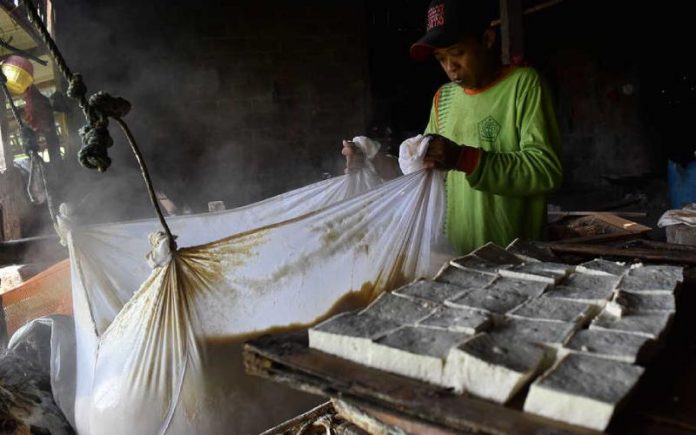The rapid growth of population in Indonesia demands food security that can meet the needs of the population. One of the increasing demand for soybeans. Based on information from http://www.kemenperin.go.id , Director General of Small, Medium Industries (IKM) of the Indonesian Ministry of Industry, Euis Saedah explained that there are currently around 11,500 tofu and tempeh producers in Indonesia. Soybean needs for tofu and tempeh production range from 50-100 kg per day. Tofu and tempeh production is so high that it also requires industrial management for its byproducts. Tofu and tempeh industry activities produce solid and liquid waste. In general, solid waste is used as animal feed. Whereas wastewater generated from industry needs to be managed so that it is safe.
Tofu or tempeh industry wastewater that is not managed properly can affect the environment, such as from the odor and eutrophication of polluted water. Tofu industry wastewater contains high protein, so it has high nitrogen and phosphate content in wastewater, causing an unpleasant odor and eutrophication. The Governor of East Java Province has made regulations determining the standard limit for soybean industry wastewater in the East Java area, as stated in East Java Governor Regulation No.72 of 2013.
The existence of regulations regarding the limit standard of wastewater in the tofu/tempeh industry makes it a challenge for the industry to treat wastewater. In general, tofu and tempeh industries have similarities in their industrial operations. The tofu industry generally operates around 8 hours to produce tofu, after that it stops operating and continues the next day. This industrial operation rhythm requires simple and appropriate wastewater treatment according to operating hours. Sequencing Batch Reactor (SBR) is a simple wastewater treatment system operating with a closed system and consists of several stages. There are 4 stages in this treatment, stage of filling wastewater to the processing unit (fill), the processing stage (react) in the treatment unit, the settling stage (settle), the stage of removing part of the wastewater (draw), and the stationary stage or not doing anything (idle). After the last stage, the next stage can be carried out, the fill stage. The react process is continued with the addition of oxygen intake to maximize the wastewater treatment process.
SBR is biological wastewater treatment, especially using the help of microorganisms. The microorganism works as an organic load removal agent in wastewater. The main key in this SBR process is the start-up SBR by selecting microorganism seeds in the form of mud which can optimally treat wastewater with biological processes. Sludge from tofu waste deposits can be used by treating wastewater. The sludge in the form of mud was added at the beginning of the SBR process. Microorganisms in sludge will use organic material in wastewater to metabolize microorganisms themselves.
This wastewater treatment process can set aside organic load in tofu wastewater as indicated by the decreasing Chemical Oxygen Demand (COD) up to 90% as well as the value of Total Suspended Solid (TSS) down by up to 90%. The final value of this processed SBR is COD at 500 mg / l and TSS at 175 mg / l. Compared to the East Java Governor Regulation No. 72 of 2013, the specified standard limit for COD value is 300 mg / l and TSS of 100 mg / l. Although it needs further processing so that the output of wastewater treatment can be in the ranged of the standard limits, advanced treatment can use aquatic plants to reduce COD and TSS.
The advantage of SBR technology is its flexibility to be several processes in one container, so it does not require a large place. The four stages of SBR are carried out in one container with an unsustainable system. So that when the tofu factory stops producing, it can be used for the SBR process, while when the plant starts operating, the treated wastewater can proceed to the second processing stage. The budget for SBR is inexpensive because there is only one investment for the processing unit. It is suitable for small and medium industries such as tofu and tempeh factories. The weakness of this unit is that it is not suitable for large-scale industry.
Author : Nur Indradewi Oktavitri, S.T., M.T.
The details of research available at:
https://iopscience.iop.org/article/10.1088/1755-1315/259/1/012017
Nimash Miftahul Sakinah; Lintang Tubagus Rahmatullah, Eko Prasetyo Kuncoro dan Nur Indradewi Oktavitri. 2019. Performance of sequencing batch reactor (SBR) of treated tofu wastewater: Variation of contact time and activated sludge sources. IOP Conf. Series: Earth and Environmental Science, volume 259 012017.





